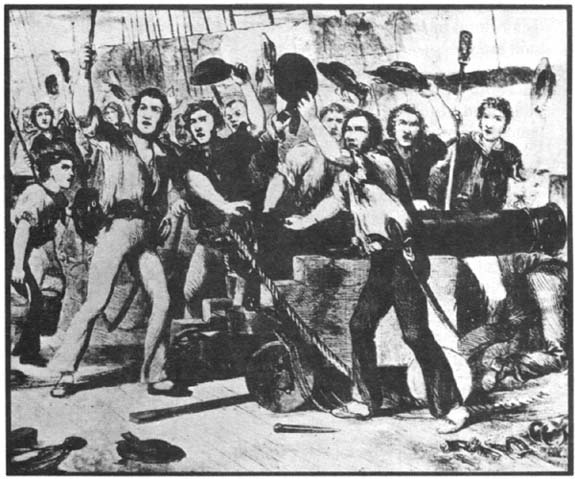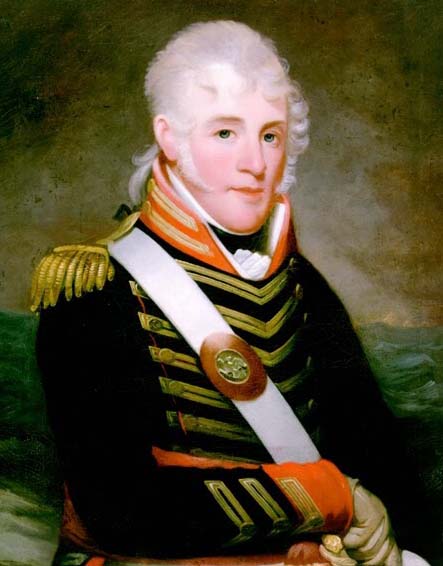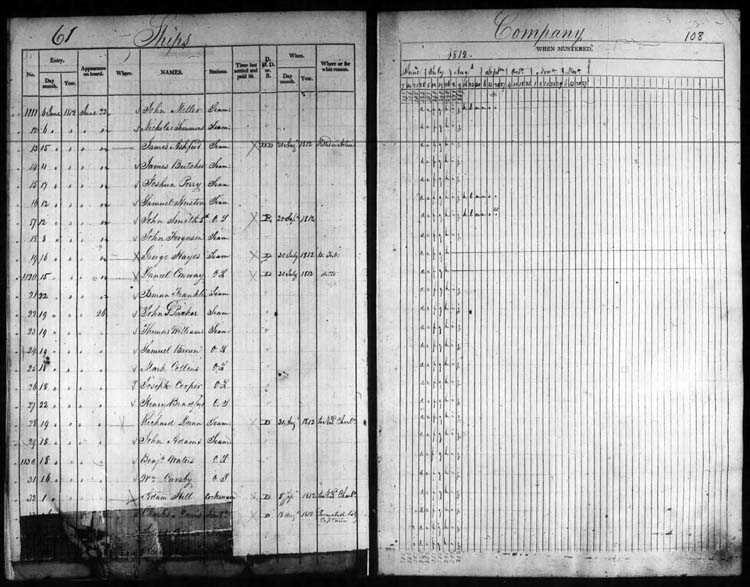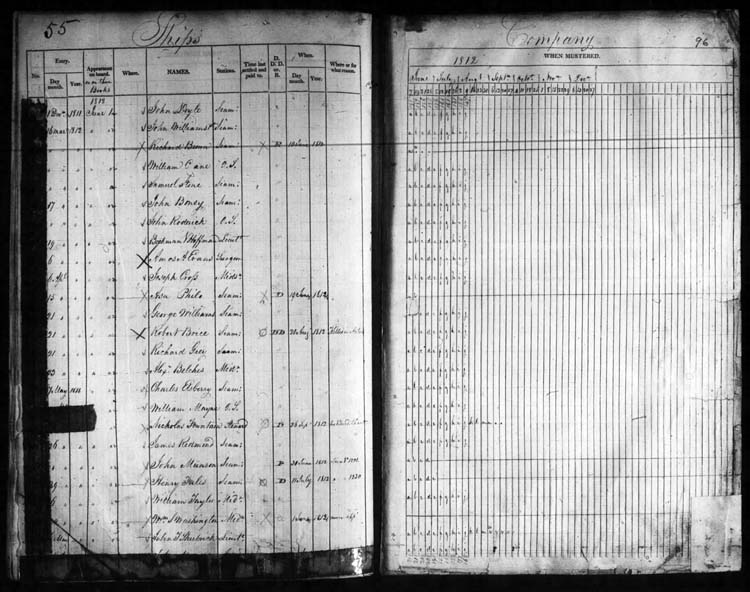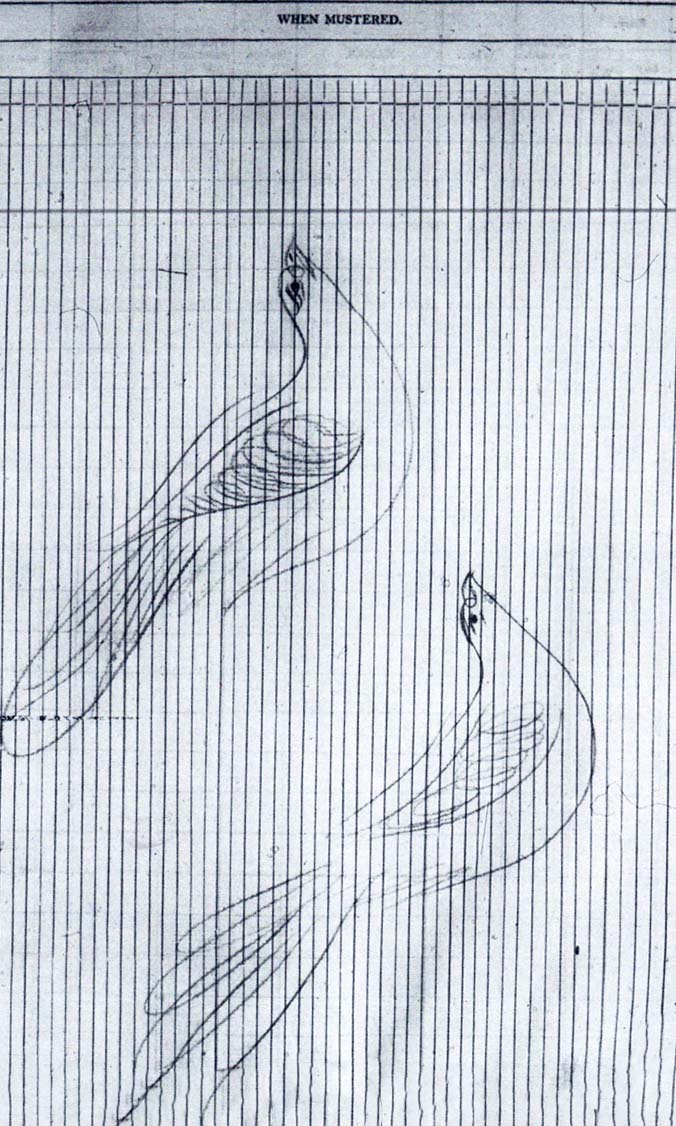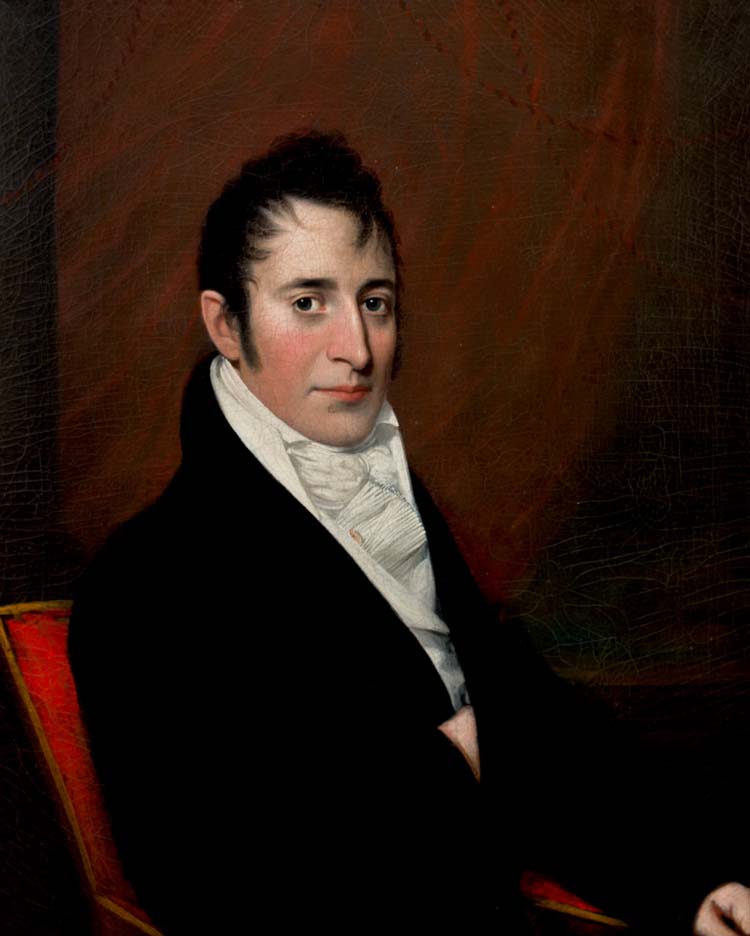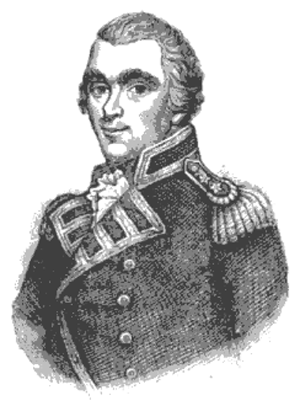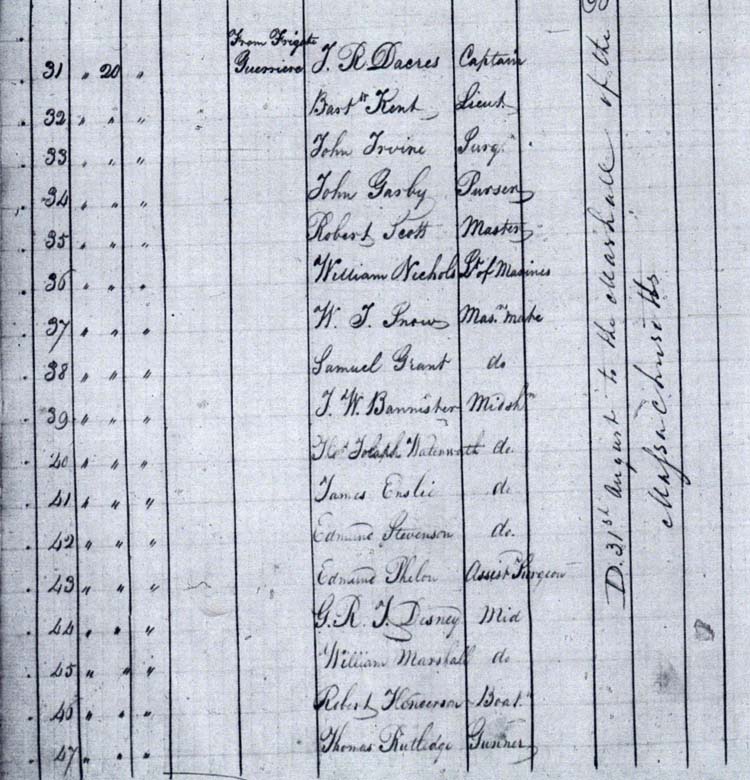An Epic Battle
USS Constitution vs HMS Guerriere
BY
JOHN G. M. SHARP
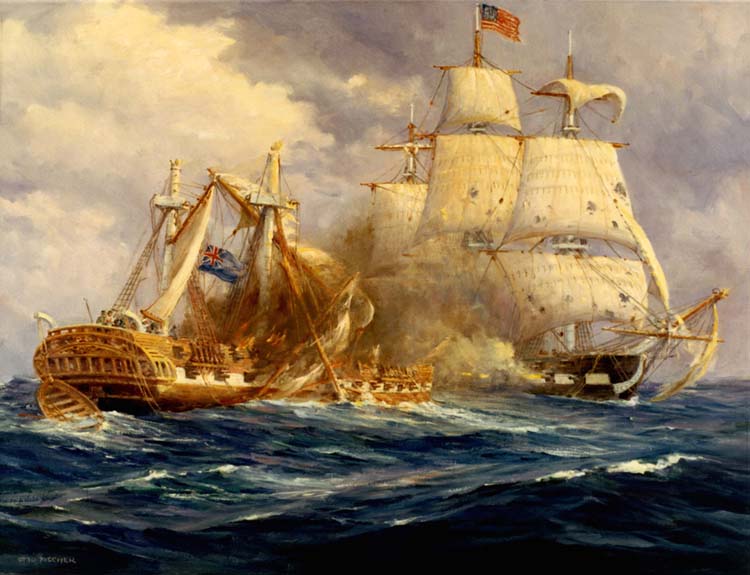
"The first victory at sea by USS Constitution over HMS Guerriere" Anton Otto Fischer
At 2:00 p.m. on 19 August 1812, the USS Constitution had sighted a large ship to leeward and bore down to investigate.1, 1aA The weather was cloudy and the wind was brisk. The strange ship proved to be Guerriere, whose crew recognized Constitution at about the same moment. Both ships prepared for action, and shortened sail to "fighting sail", i.e. topsails and jibs only. As Constitution closed, Captain James Richard Dacres of HMS Guerriere first hove to and fired a broadside which fell short, and then ran before the wind for three quarters of an hour with the Constitution on Guerriere's quarter.
1. The apparent confusion as to the date of the battle is due to it being recorded on the USS Constitution deck logs and muster rolls in sea time as 20 August 1812, while Captain Isaac Hull’s letter to Secretary of the Navy, Paul Hamilton, dated 28 August 1812 correctly noted the date of the battle as "the 19th inst., at 2 PM being in Latitude 41˚, 42˚". The discrepancy caused by the fact that early naval logbook records were all kept in sea time. This old fashion way of keeping the date at sea was to consider, the day and the date to commence at noon and to end and begin in the following noon, so that they sea day and date began twelve hours before the civil date and twenty four hours before the astronomical date. See Patterson, Harold, The Navigators Pocket- book, (Charles Scribner, New York, 1917), p.127 , https://books.google.com/books?id=LHpGAQAAMAAJ&pg=PA87&dq=Log+books+and+%22sea+time+%22&hl=en&newbks =1&newbks_redir=0&sa=X&ved=2ahUKEwid1a7hvqz1AhXklOAKHQHXDr4Q6AF6BAgJEAI#v=onepage&q=sea%20day&f=false
1A. , For nautical expressions and terms, please see, Smyth, William Henry The Sailor's Word-Book An Alphabetical Digest of Nautical Terms, including Some are Especially Military and Scientific, but Useful to Seamen; as well as Archaisms of Early Voyagers, etc. (Blackie and Son, Glasgow, 1867) https://books.google.com/books?id=y7HqO9XAwk8C&printsec=frontcover&dq=1867,+William+Henry+Smyth.&hl=en&newbks =1&newbks_redir=0&sa=X&ved=2ahUKEwjerrKuy6z1AhWimGoFHcjYCFQQ6wF6BAgDEAE#v=onepage&q
=1867%2C%20William %20Henry%20Smyth.&f=falseCapt Dacres yawed several times (moving the ship about its vertical axis to steady it) and fired broadsides at Constitution, but Guerriere's broadsides were generally inaccurate, likewise the few shots fired from Constitution's foremost guns had little effect. After one cannonball bounced "harmlessly" off the side of Constitution, a crew member is said to have yelled "Huzzah! Her sides are made of iron!"2
2. The War of 1812: Writings from America’s Second War of Independence Donald R. Hickey, editor (Library of America: New York, 2013), p. 125.
USS Constitution gun crew preparing for battle, artist unknownAt 6.00 p.m., the Constitution ranged up on the Guerriere and once the two had closed to within 200 yards. For weeks prior to the engagement, Captain Hull had regularly trained his gun crew to fire their cannons on the down roll for maximum effectiveness in sending their shot directly into an opponent’s hull.3 Captain Hull ordered extra sail (the foresail and main topgallant sail) to be set to close the distance quickly. The Guerriere's 18 pounder fired first, then First Lieutenant Morris asked Captain Hull, "Shall we return fire?" Captain Hull replied, "Wait", for he intended to open fire with a single concentrated broad side at close range. As the two vessels came abeam, Hull told Morris, "Yes, you may fire!" The Constitution fired double shotted broadsides at "half pistol-shot" range, with Constitution to starboard and Guerriere to port. The noise and shock of the broadside was something that both crews would remember, for "every spar on the Constitution trembled and the entire ship shook from stem to stern."4 The Guerriere reeled as though in an earthquake. The force of Constitution's broadside had sent hundreds of pounds of metal crashing through her hull and superstructure. Everywhere men fell to large wooden splinters and metal piercing flesh. Hull, like many veteran naval officers, in later life would suffer profoundly from a loss of hearing, possibly the result of his exposure on deck that day to the incredible loud cacophony of roaring cannons.5
3. Maloney, Linda M., The Captain from Connecticut: The Life and Naval Times of Isaac Hull (Boston: Northeastern University Press, 1986), p. 188
4. Toll, Ian W., Six Frigates, the Epic History of Founding of the U.S. Navy (W. W, Norton & Co, New York, 2008), p.349.
5. Maloney, pp. 437-438.
After fifteen minutes of this exchange during which Guerriere suffered far more damage than Constitution due to the latter's larger guns and thicker hull, Guerriere's mizzenmast fell overboard to starboard, acting like a rudder and dragging her around. On the Guerriere, the Constitution’s raking fire killed the first, second and third lieutenants.6
6. Toll, p. 351.
This allowed Constitution to cross ahead of Guerriere, firing a raking broadside which brought down the main yard. Hull then wore ship to cross Guerriere's bow again, firing another raking broadside, but the maneuver was cut too close and Guerriere's bowsprit became entangled in the rigging of Constitution's mizzenmast. Quarter gunner Moses Smith recalled.7
Our stern guns were pouring in upon them, so we raked the ship fore and aft. Every shot told well. In a few moments the foremast was gone and our prediction was fulfilled, the Guerriere had become a sloop. Soon after the mainmast followed, rendering her a complete wreck … The Constitution itself was hardly touched except in some of the yards and sails
7. The War of 1812: Writings from America’s Second War of Independence Donald R. Hickey, editor (Library of America: New York, 2013), p. 125.
Within a half hour of the commencement of the engagement, the Guerriere had been transformed into a hulk and the lower deck into a charnel house. Lt. Henry Gilliam USN, part of the American boarding party, later wrote his uncle,8
"I do assure you I had one of the most convincing & awful examples of the Tyranny of Kings in contemplating the scene which her deck presented; pieces of skulls, brains, legs, arms & blood lay in every direction and the groans of the wounded were enough to almost make me curse the war… After getting our prisoners we found her in such a shattered condition & great distress, we were under the painful necessity of setting fire to his Britannic Majesty's frigate...
8. Hawes, Lilla M. "LETTERS OF HENRY GILLIAM, 1809-1817." The Georgia Historical Quarterly, vol. 38, no. 1, Georgia Historical Society, 1954, p. 61.
An American merchant captain, held prisoner on the Guerriere, recalled the battle and the Constitution’s opening salvo.9
For a moment it appeared as if heaven and earth had struck together; a more terrific shock cannot be imagined. Before those in the cockpit had adjusted themselves, the blood ran down from the deck freely as if a washtub- full had been turned over; and the wounded and dying were handed down just as fast as men could part the cockpit was filled.
9. "Reminiscences of the Last War with England", Historical Magazine and Notes and Queries, Volume 17, 1870, pp. 31-33, reprint of the New York Evening Post, 1 December 1868, "Reminiscences of the Last War with England", by "Octogenarian"
In all, the HMS Guerriere had lost twenty-three killed and fifty-six wounded. Compared to only seven of Hull’s crew killed and seven wounded. Aboard Constitution, Lieutenant William S. Bush was killed and Lieutenant Charles Morris wounded by musket shots.10
10. Dudley, William S. , Inside the U S Navy of 1812-1815, (Johns Hopkins University Press: Baltimore, 2021), p. 30.
The Men of the USS Constitution Killed in Action with HMS Guerriere
The information below on the seven members of the crew of the USS Constitution killed in action, during the frigate's epic battle with HMS Guerriere, was found in "Crew Profiles", USS Constitution Museum website https://ussconstitutionmuseum.org/crew/ The images from the muster rolls of the USS Constitution and information therein was found in the Miscellaneous Records of the Office of Naval Records and Library, 1803-1859, Miscellaneous Records of the Navy Department, Roll, 0094, pp. 38-79, Record Group 45, National Archives and Records Administration, Washington D.C.
Lt. William Sharp Bush USMC KIA 19 August 1812Lt. William Sharp Bush IMAGE as the HMS Guerriere drew close to the USS Constitution, Lieutenant William S. Bush, USMC, prepared to lead a boarding party. He "leaped up onto the taffrail, (rail around a ship's stern) sword in hand and was shot in the face."11 His death made Lt. Bush, the first Marine killed in combat; his body was later buried at sea with six other Americans and twenty-three British sailors killed on Guerriere in a joint ceremony.12 He was born July 27, 1786 in Wilmington, Delaware. William Sharp Bush was the son of John Bush, a veteran of the American Revolutionary War. The family’s circumstances prevented the young man from attending college, but he did receive the benefits of a private tutor, enabling him to "acquire a fund of information calculated to give him a dignified rank in the general round of conversation." With a good "English" education under his belt, his father placed him in the care of a merchant to learn the secrets of a successful business. The world of the counting house held no appeal for Bush, however, and he soon moved to the country to take up farming. In 1807, following the British attack on the frigate Chesapeake, Bush sought a commission in the state militia. "Ambition and his love of country" united and the following summer he received a commission as a second lieutenant in the Marine Corps. In March 1811 he was promoted to first lieutenant. A Marine lieutenant made $30.00 per month. For further biographical information see https://www.findagrave.com/memorial/124356092/william-sharp-bush
11. Toll, p. 351.
12. The Naval War of 1812: A Documentary History,Volume I, editor, William S. Dudley, (Naval Historical Center, Government Printing Office, Washington D.C., 1985), p. 246.
Caleb Smith IMAGE Seaman, place and date of birth are unknown, enlisted in the US Navy on June 16, 1812 in Philadelphia, PA. He joined Constitution’s crew as an able seaman on July 2, 1812 while the ship lay at Annapolis, Maryland. He was killed in action on 19 August 1812 which was recorded as 20 August 1812, on the USS Constitution muster rolls, and was subsequently buried at sea. Please see end-note # 1 re dates of death.
James Ashford, Seaman, place and date of birth are unknown, entered the United States Navy on June 15, 1812 and enlisted as an able seaman for the crew of USS Constitution on June 22 in the Washington Navy Yard. He was killed in action on 19 August 1812 which was recorded as 20 August 1812, on the USS Constitution muster rolls, and was subsequently buried at sea. Please see end-note # 1 re dates of death.
Robert Brice IMAGE Quarter Gunner. Brice lived in New London, Connecticut, before moving to Providence, Rhode Island, in 1812. Brice previously served aboard USS Essex, a 36-gun fifth rate frigate. Brice joined USS Constitution on August 4, 1811. Due to his previous experience, Brice was an able seaman. He was also rated as a quarter gunner, aiding the gunner and gunner’s mate with the maintenance of the guns on board; this duty earned him $19 per month. While on board Constitution, Brice made a diplomatic voyage to France and Holland. He was killed in action on 19 August 1812 which was recorded as 20 August 1812, on the USS Constitution muster rolls, and was subsequently buried at sea. Please see end-note # 1 re dates of death. (He was killed in action on 19 August 1812 which was recorded as 20 August 1812, on the USS Constitution muster rolls, and was subsequently buried at sea. Please see end-note # 1 re dates of death.) After his death his widow, Nancy Brice, who lived in Norwich, Connecticut, received $72 a year for 10 years until she remarried.
Henry A. Fales IMAGE Ordinary Seaman (p. 44). Fales place and date of birth are unknown. He entered USS Constitution on February 9, 1811 at New London, Connecticut. His rank was ordinary seaman. He was promoted to steward on March 9, 1812. On April 29, 1812 he was designated able seaman. Fales died on July 20, 1812. Fales died on July 20, 1812 from unspecified causes on board USS Constitution. He was buried at sea.
James Read IMAGE Seaman (p. 60)Place and date of birth are unknown. Read transferred to USS Constitution as an able seaman on 5 May 1812. He was killed in action on 19 August 1812 which was recorded as 20 August 1812, on the USS Constitution muster rolls, and was subsequently buried at sea. Please see end-note # 1 re dates of death.
Jacob Sego IMAGE Seaman (p. 68). Place and date of birth are unknown. Sego transferred to USS Constitution as an able seaman on August 4, 1811. He was killed in action during the battle with HMS Guerriere on August 19, 1812, which was recorded as 20 August 1812, on the USS Constitution muster rolls, and was subsequently buried at sea. Please see end-note # 1 re dates of death.
Two muster rolls of the USS Constitution from the Miscellaneous Records of the Office of Naval Records and Library, 1803-1859, Miscellaneous Records of the Navy Department, Roll, 0094, pp. 38-79, Record Group 45, National Archives and Records Administration, Washington D.C.
THE AFTERMATH OF BATTLE
In early September 1812, the USS Constitution’s Purser, Thomas John Chew, USN, recorded the names of those crewman killed in action and on 19 August 1812 with HMS Guerriere. Purser Chew knew many of these men. On a separate page (p.59), he or his clerk, sketched these two doves on the frigates muster roll. The dove is often view as a symbol of mourning.
Thomas John Chew was born on January 28, 1777, in New London, Connecticut, to Samuel and Lucy Miller Chew. He entered the United States Navy in 1799 for service in the Quasi-War with France and secured a purser’s commission in 1809. As purser Chew was a commissioned officer responsible for keeping the ship’s pay and muster rolls, accounting for provisions, selling clothing and non-ration items to sailors, and keeping detailed account books. While at sea Chew exchanged frequent correspondence with his colleagues and his wife, Abigail Hallam. Chew’s family was financially comfortable, thanks to his position and investments, and he often indulged in fine clothing and gifts.
On June 1, 1812, Chew joined USS Constitution’s crew and was aboard during the engagement with HMS Guerriere on August 19, 1812. For his service in battle, he was awarded a Congressional Silver Medal and shared in the crew’s $50,000 prize money. Chew departed Constitution on September 26, 1812, acting as purser of the Boston Navy Yard, and later transferred to USS Chesapeake. He resigned from the navy on March 12, 1821 and died in 1846.
Captain James Richard Dacres and the HMS Guerriere
Captain James Richard Dacres is chiefly remembered today for his engagement on 19 August 1812 with the American frigate USS Constitution which saw the loss of his ship, HMS Guerriere.13 James Richard Dacres (22 August 1788 to 4 December 1853), was born into a naval family of both great wealth and position. Like his father, he would eventually rise to the rank of vice admiral. Likewise his uncle, brother and cousin were all serving naval officers. In eighteenth century England no pretense was made that the society people lived in was a pure meritocracy. Positions in government and the civil service were dependent on a loose system of patronage which was typical of most professions of the era. This system was operated in the Navy, as on land, with the exception that to become a lieutenant one still had to pass an examination. Beyond that point, promotion could depend on who you knew.14 Richard Dacres' father, James Richard Dacres (1749-1810), was a vice admiral by 1805. The younger Dacres had entered the Royal Navy in 1796 at the age of eight, aboard his father’s old ship the HMS Sceptre of 64 guns, as a first class volunteer. He was commissioned a lieutenant in 1800 and subsequently served with his father as flag lieutenant in a number of different positons. In 1811 Dacres was appointed to command the HMS Guerriere; originally a French frigate captured by the British on July 19, 1806.15
13 “Although this event took place on 19 August 1812, the logbook records and musters of the USS Constitution records it in sea time under the dates 19-20 August” See Ironsides! The Ship, the Men and the Wars of the USS Constitution, Brodine, Charles E., Crawford, Michael J. and Hughes, Christine F.,(Fireship Press,2007), p. 195.
14 Nelson’s Navy, “Patronage and Promotion” https://www.nelsonsnavy.co.uk/patronage.html
15 The Gentleman's Magazine, volume 195, (London, John Bowyer Nichols and Son, 1854), obituary, pp. 202 https://babel.hathitrust.org/cgi/pt?id=chi.79255342&view=1up&seq=213&skin=2021
Captain James Richard Dacres R. NOn 19 August 1812, as Guerriere, sighted the USS Constitution, Captain Dacres was twenty six years of age, and had upwards of six years as a Post-Captain.16 In his 7 September 1812 letter to Vice Admiral Herbert Sawyer (below) Captain Dacres informed his superior of the loss and destruction of HMS Guerriere. His report shows the crew of the Guerriere fought bravely and hard; overall they sustained a 30 % casualty rate! Dacres himself was seriously wounded during the battle and following the frigate’s surrender was taken prisoner with this surviving officers and crew. He briefly became a prisoner of war, but like other officers was exchanged and returned to Halifax, where he was tried by court martial for the loss of the Guerriere a standard procedure in the Royal Navy for the loss of a ship at the time. The verdict of the court absolved Captain Dacres of any blame.
"Having attended to the whole of the evidence, and also to the defense of Captain Dacres, the court agreed, that the surrender of the Guerriere was proper in order to preserve the lives of her valuable remaining crew; and that her being in that lamentable situation was from the accident of her masts going, which was occasioned more by their defective state than from the fire of the enemy, though so greatly superior in guns and men. The court do, therefore, unanimously and honorably acquit the said Captain Dacres, the officers and crew, of his majesty's late ship the Guerriere, and they are hereby honorably acquitted accordingly.17
16 The Naval Chronicle, for 1812, volume XXVIII ( July to December), editors James Stanier Clarke and John McArthur, (Joyce Gold,London, 1812,)p.384, https://archive.org/details/navalchroniclefounse
17 James, William M., The naval history of Great Britain, from the declaration of war by France in 1793, to the accession of George IV : A new ed., with additions and notes, bringing the work down to 1827, (London ,Baldwin, Cradock & Joy, 1822–4), p.408,
https://archive.org/details/navalhistoryofgr05jameuoft/page/388/mode/2up?q=dacresSimilarly the editors of The Annual Register, an authoritative London-based journal, declared, “Not the least imputation fell on Capt. Dacres or his ship's company during the action which yielded only to irresistible superiority of physical strength.”18 Scholar Christine F. Hughes in her essay Constitution verses Guerriere, has noted the continual debate among historians of the conflict, whether Constitution’s superiority in force really precluded any real chance of success for the British.19
18 Annual Register, or a View of History, Politics and Literature for the year 1812, ( London, W. Otridge and Son, 1813), p. 200, https://babel.hathitrust.org/cgi/pt?id=uva.x002707399&view=1up&seq=220&skin=2021&q1=Dacres
19 Ironsides! The Ship, the Men and the Wars of the USS Constitution, Brodine, Charles E., Crawford, Michael J. and Hughes, Christine F., (Fireship Press, 2007), p. 117.
The man who set off the debate (1816) was British writer William M. James. In 1827 James revisited and expanded this theme in six volumes, History of the Naval Campaigns of the French Revolutionary and Napoleonic Wars.20In his research for volume five which covered the War of 1812, James, a lawyer by profession, actually managed to board American warships and speak to their crews. Once on board, he was able to measure and verify their characteristics at first hand. In this pursuit James noted, that the USS Constitution was not only much larger, but also more heavily manned and armed, than HMS Guerriere, contrary to previous American claims that the ships had been equal at the time of their engagement.21 James could and did chastise the British. For instance, regarding Captain Dacres letter of 7 September 1812, he is harshly critical of the letter’s “lack of detail.”22 Also, in his narrative and footnotes, James could be “bitterly sarcastic” However as Ian Toll writes, on the whole James demonstrated convincingly that many of the American successes in the naval war were due to the superior size and armament of American ships.23 For example, James repeatedly pointed to the disparity “one third in guns and two thirds in men” as the real inequality of force that existed between Guerriere and Constitution.24
20. James William M., .An Inquiry into the merits of the principal naval actions between Great Britain and the United States: comprising an account of all British and American ships of war captured and destroyed since 18 June 1812 (Halifax: Holland, 1816).
21. James, William M., The Naval History of Great Britain, Volume V, (Macmillan and Company, New York, 1902), pp 403-404 https://archive.org/details/navalhistoryofgr05jameuoft/page/388/mode/2up?q=dacres
22. James, p. 425, (letter of Captain Dacres, his address to his court-martial) “… is the most barren of details. It happens, also, that the letters of Commodore Decatur, and the other American accounts of this action, are equally brief and unsatisfactory.”
23. Toll, Ian W., Six Frigates, the Epic History of Founding of the U.S. Navy (W. W, Norton & Co, New York, 2008), p.461
24. James, p.403
USS Constitution, 1812, muster roll, p.20,
partial list British POW’s, frigate, Guerriere, August 20, 1812
(double click to enlarge)The American response to James came in 1882 from a young Theodore Roosevelt, then a Harvard undergraduate. Roosevelt conceded that James,25
Is by far the most valuable authority on the war as regards purely British affairs. He enters minutely into details and has evidently laboriously hunted up his authorities. He has examined the ships’ logs, the Admiralty reports, various treatises, all the Gazette reports, gives very well-chosen extracts, has arranged his work in chronological order, discriminates between the officers that deserve praise and those that deserve blame and in fact writes a work which ought to be consulted by every student of naval affairs.
25. Roosevelt, Theodore, The Naval War of 1812 or the History of the United States Navy During the Last War With Great Britain, (G.P. Putnam Sons, New York, 1882), p.52, https://archive.org/details/navalwarof1812mo00theo/mode/2up?q=%22The+Naval+War+of+1812%22+Roosevelt
Roosevelt after consulting the muster logs, than proceed to examine James’ statements regarding the composition of the respective crews and found, James wrong in his assertions that,26
The American ships had no boys; they had nearly as much in proportion as the British. The Constitution had 31, the Adams 15, etc. So, when he states that our midshipmen were generally masters and mates of merchantmen;,they were generally from eleven to seventeen years old at the beginning of the war, and, besides, had rarely or never been in the merchant marine.
26. Roosevelt, p. 63.
While Roosevelt did not dismiss James main thesis, he carefully reminded his readers, “But it must always be remembered that untrustworthy as James is in anything referring purely to the Americans, he is no worse than his compeers of both nationalities.”27
27. Roosevelt, p. 53.
Modern scholarship, after closely examining James critique, generally agreed, “Constitution’s superior strength, heavier guns and larger better-trained crew enabled more rapid firing and more accurate shooting.”28 Captain Dacres in his explanation to the court did not cite the Constitution’s significant advantage in broadside weight, nor did he suggest that this was a crucial factor in the defeat.
In fact, aside from mentioning the Constitution’s broadside, he does not emphasize that he was out-gunned at all. He does say that “the Enemy had such an advantage from his Marines and Riflemen, when close and his superior sailing enabled him to choose his distance.29
28. Dudley, Donald S. Inside the US Navy of 1812-1815, (Johns Hopkins Press, Baltimore, 2021), p. 30.
29. Kaizer, Nicholas James Regret, Determination, and Honour, The Impact of the Single Ship Losses in North American Waters on the British Royal Navy, 1812-1815, Master of Arts thesis, Dalhousie University, Halifax, Nova Scotia, 2018, p.58 https://dalspace.library.dal.ca/bitstream/handle/10222/74119/Kaizer-Nicholas-James-MA-HIST-June-2018.pdf?sequence=3&isAllowed=y
William James, himself conceded “There is no question; our vanity received a wound in the loss of the Guerriere.30
30. James, William, Naval Occurrences of the War of 1812, A full and Correct Account of the Naval War Between Great Britain and the United States, 1812-1815, Introduction, Andrew Lambert, (T. Egerton, London, 1817), reprinted (Conway Maritime Press, London, 2004) p. 57.
The “inexperienced” Captain Dacres had little choice but to fight, despite the fact that his frigate was in poor material condition and faced a much larger vessel. Adding to his difficulties, as Andrew Lambert explains to Captain Isaac Hull, he faced “an expert opponent.”31 Dacres' “only hope of avoiding defeat lay in running away, a tactical choice that would have seen him cashiered or shot.”32 While the contest was unequal, the loss of the Guerriere on 19 August 1812 to the American frigate Constitution did not change the balance of the war, but it provoked deep shock and shame within the Royal Navy.33 Theodore Roosevelt understood the American frigate was better manned and more heavily armed than its opponent, but stressed,34
it must always be remembered that a victory, honorably won, if even over a weaker opponent, does reflect credit on the nation by whom it is gained….Some of my countrymen will consider this scan approbation to which the answer must be that history is not a panegyric.
31. Lambert, Andrew, The Challenge Britain Against America in the naval War of 1812, (Faber and Faber, London, 2013), pp. 76-77.
32. Lambert, p. 79.
33. Kaizer, p.7.
34. Toll, p. 464.
* * * * * *
John "Jack" G. M. Sharp resides in Concord, California. He worked for the United States Navy for thirty years as a civilian personnel officer. Among his many assignments were positions in Berlin, Germany, where in 1989 he was in East Berlin the day the infamous wall was opened. He later served as Human Resources Officer in South West Asia (Bahrain). He returned to the United States in 2001 and was on duty at the Naval District of Washington on 9/11. He has a lifelong interest in history and has written extensively on the Washington, Norfolk and Pensacola Navy Yards, labor history and the history of African Americans. His previous books include African Americans in Slavery and Freedom on the Washington Navy Yard 1799 -1865, Morgan Hannah Press 2011 and History of the Washington Navy Yard Civilian Workforce 1799-1962, 2004.
https://www.history.navy.mil/content/dam/nhhc/browse-by-topic/heritage/washington-navy-yard/pdfs/WNY_History.pdf
and the first complete transcription of the Diary of Michael Shiner Relating to the History of the Washington Navy Yard, 1813-1869, 2007/2015 online:
https://www.history.navy.mil/research/library/online-reading-room/title-list-alphabetically/d/diary-of-michael-hiner.html
His most recent work includes Register of Patients at Naval Hospital Washington DC 1814 With The Names of American Wounded From The Battle of Bladensburg 2018,
https://www.history.navy.mil/research/library/online-reading-room/title-list-alphabetically/r/register-patients-naval-hospital-washington-dc-1814.html
The last three works were all published by the Naval History and Heritage Command. John served on active duty in the United States Navy, including Vietnam service. He received his BA and MA in History from San Francisco State University. He can be reached at sharpjg@yahoo.com
